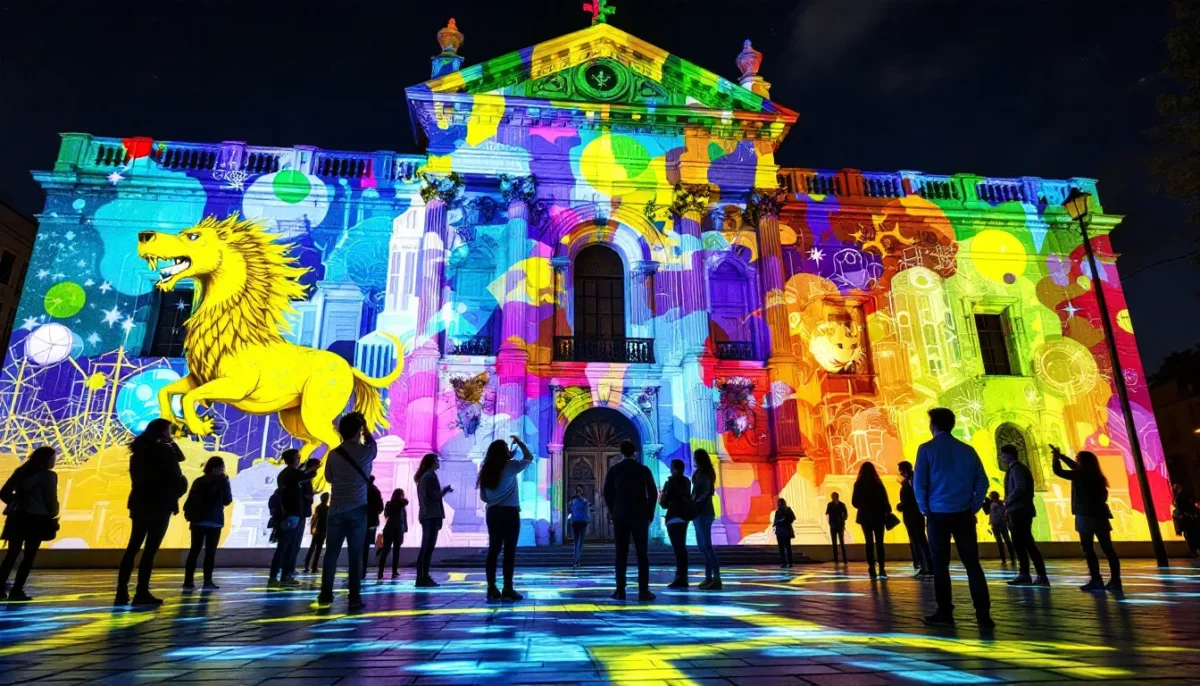In today’s art world, something exciting is happening. Art isn’t just hanging on walls anymore—it’s all around us, changing how we experience creativity. Immersive art audience engagement is transforming regular gallery visits into adventures where you become part of the artwork itself. From rooms filled with infinity mirrors to digital waterfalls that respond to your movements, these experiences are changing our relationship with art forever. Instead of just looking at art, we’re now stepping inside it, touching it, changing it, and connecting with it using all our senses.
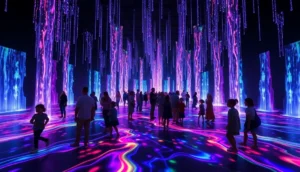
Key Points:
- Immersive art turns viewers into active participants
- Multi-sensory experiences create stronger emotional connections
- Technology like digital projection enables new forms of engagement
- Successful installations blend artistic vision with audience interaction
- The immersive art movement is growing globally across museums and dedicated spaces
The Evolution of Immersive Art Audience Engagement
Art hasn’t always invited people to touch, explore, and change it. For centuries, museums were quiet places with strict rules. Look, but don’t touch. Stand behind the line. No photos. Today’s immersive art takes the opposite approach—it only comes alive when you interact with it.
Early forms of immersive experiences date back to panoramic paintings of the 1800s, where visitors stood inside circular rooms surrounded by massive landscapes. But modern immersive art truly began in the 1960s and 70s with installation art and environments that surrounded the viewer. Artists like James Turrell created rooms where light became a physical presence you could almost touch.
The big change came with technology. As digital art revolution transformed artistic expression, artists gained new tools to create responsive environments. Suddenly, art could see, hear, and respond to visitors in real time.
Timeline: Evolution of Audience Engagement
| Time Period | Approach to Audience | Examples |
|---|---|---|
| Pre-1900s | Passive observation | Traditional gallery paintings |
| Early 1900s | Limited immersion | Panoramas, dioramas |
| 1960s-70s | Environmental immersion | Installation art, light art |
| 1990s-2000s | Physical interaction | Interactive installations |
| 2010s-Present | Multi-sensory digital immersion | Digital projection, responsive environments |
Why Immersive Art Creates Powerful Connections
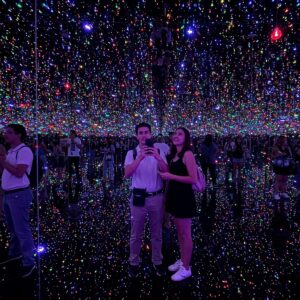
When you walk through a digital waterfall that parts around your body or enter a room where thousands of lights respond to your movement, something special happens in your brain. These experiences trigger responses that flat, traditional art often can’t match.
The secret is in using multiple senses at once. Our brains form stronger memories when information comes through several channels—seeing, hearing, touching, and sometimes even smelling. This is why people often remember immersive art experiences years later, while they might forget a painting they saw last month.
Research shows that physical movement through space also helps us process and remember experiences better. When you walk through an installation like Meow Wolf’s House of Eternal Return, you’re not just seeing art—you’re creating a memory map tied to your own movement.
“When art engages all of our senses, it speaks to us on a level beyond words, reaching places within us that rational thought cannot access.”
Olafur Eliasson
Technologies Creating New Forms of Engagement
Today’s most impressive immersive experiences rely on advanced technology that wasn’t available even a decade ago. These tools have opened up entirely new possibilities for artists using light and space to create emotion.
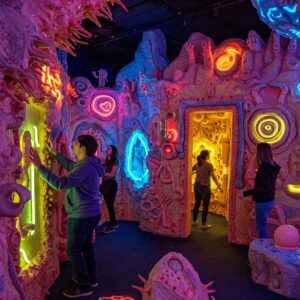
Digital Projection Mapping
This technology transforms ordinary surfaces—buildings, walls, floors—into dynamic canvases. By precisely mapping projections onto irregular surfaces, artists can transform entire rooms into living, moving environments. TeamLab, a Japanese art collective, uses this technology to create spaces where digital flowers bloom around visitors’ feet as they walk.
Interactive Sensors
Motion sensors, pressure pads, cameras, and microphones allow artworks to “see” and “hear” visitors. When an installation knows you’re there, it can respond to your presence, movement, voice, or touch. In Random International’s famous “Rain Room,” sensors detect visitors’ bodies and stop the rain directly above them, creating the magical experience of walking through rainfall without getting wet.
Spatial Sound Design
Immersive audio places different sounds around a space, creating environments that feel real even with your eyes closed. Artists carefully design soundscapes that change as you move through an installation, guiding your experience and emotional response.
Masters of Immersive Engagement
Several artists and collectives have become famous for creating powerful immersive experiences that draw huge crowds worldwide.
TeamLab
This Japanese art collective brings together artists, programmers, engineers, and designers to create breathtaking digital experiences. Their permanent museums in Tokyo, Shanghai, and other cities feature rooms where digital waterfalls flow around visitors, flowers bloom and die in response to human touch, and light sculptures respond to movement. What makes TeamLab unique is how their installations remember visitor interactions, allowing the artwork to evolve throughout the day.
Meow Wolf
Starting as a small artist collective in Santa Fe, Meow Wolf has grown into a major force in immersive art. Their installations tell stories through environments visitors can literally climb through, with hidden passages, interactive elements, and narrative mysteries to solve. The House of Eternal Return in Santa Fe invites visitors to explore a seemingly normal house that contains portals to fantastic dimensions, combining art installation with elements of escape rooms and adventure games.
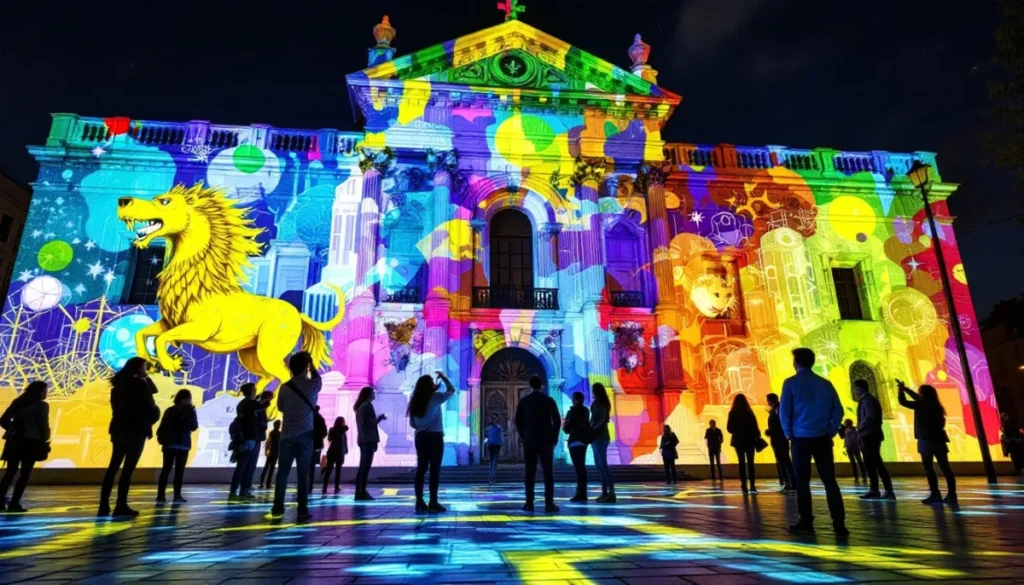
Yayoi Kusama
Japanese artist Yayoi Kusama’s Infinity Mirror Rooms create the illusion of endless space using mirrors and lights. These small rooms offer profound experiences of infinity and self-reflection (both literally and figuratively). Kusama’s work demonstrates that immersive art doesn’t require complex technology—sometimes mirrors, lights, and a brilliant concept are enough to create unforgettable experiences.
Olafur Eliasson
Danish-Icelandic artist Olafur Eliasson creates installations that make natural phenomena tangible. His famous “Weather Project” transformed the Tate Modern’s massive turbine hall into a space with a glowing sun and mist. Visitors laid on the floor for hours, basking in the artificial sunlight and watching their reflections in the mirrored ceiling—proving the power of environmental art to change human behavior.
From Looking to Doing: Participation Levels
Not all immersive art works the same way. Some experiences invite deep participation, while others create immersion while keeping the audience as observers. Understanding these different approaches helps appreciate the range of experiences available in interactive art exhibitions.
Passive Immersion
Some installations surround you with sights, sounds, and sensations but don’t require your active participation. The popular Van Gogh immersive exhibitions project the artist’s paintings across entire rooms, enveloping visitors in swirling stars and sunflowers while music plays. You’re immersed in the experience but not changing it.
Reactive Participation
These installations respond to your presence or movement, but don’t require deliberate interaction. In TeamLab’s “Borderless” exhibitions, digital waterfalls part around your body as you approach, and flowers bloom where you stand—but you don’t need to do anything specific to trigger these reactions.
Active Participation
Some works require your deliberate engagement. “Rain Room” by Random International only works when visitors move through it, creating the experience of walking through rainfall without getting wet. The artwork literally doesn’t function without audience participation.
Creative Contribution
The deepest level of engagement comes when visitors add to the artwork itself. In some installations, visitors leave marks, attach objects, or create content that becomes part of the work. These installations evolve over time through audience contributions.
The Participation Spectrum
- Level 1: Being present (surrounded by the work)
- Level 2: Moving through the work
- Level 3: Triggering reactions through movement
- Level 4: Deliberate interaction with elements
- Level 5: Creative contribution to the work
Creating Successful Immersive Experiences
For museums, galleries, and artists looking to develop engaging immersive experiences, several factors prove critical to success. Modern art museums creating engaging visitor experiences have learned important lessons about what works.
Balancing Guidance and Discovery
The best immersive installations strike a careful balance between guiding visitors and allowing them to discover things on their own. Too much instruction can make an experience feel like following directions, while too little can leave people confused.
ARTECHOUSE, which specializes in immersive digital art spaces in New York, DC, and Miami, designs installations with multiple layers. Casual visitors can enjoy the surface experience, while those who explore more deeply discover additional interactions and meanings.
Accessibility Considerations
Truly successful immersive art works for everyone. This means considering physical accessibility for visitors with mobility challenges, but also sensory accessibility for those with vision or hearing differences. The best installations offer multiple ways to engage with the work.
Social Sharing vs. Personal Experience

Many immersive art experiences have become famous through social media. While “Instagrammable” moments help market exhibitions, the most memorable installations balance photogenic elements with deeper experiences that can’t be captured on camera.
Measuring the Impact of Immersive Engagement
How do we know if immersive art is really connecting with audiences? Several approaches help measure this special form of engagement.
Beyond Attendance Numbers
While high visitor numbers indicate popularity, they don’t necessarily reflect deep engagement. Many immersive art spaces now track:
- Average time spent in the exhibition
- Return visits (people coming back multiple times)
- Specific interactions with individual elements
- Social media sharing and sentiment
The Business of Immersion
The success of immersive art has created a growing industry. Ticket prices for immersive experiences often exceed traditional museum admission, with visitors willing to pay premium prices for unique experiences. This has led to both artist-driven spaces like Meow Wolf and commercial ventures adapting famous artists’ work into immersive formats, as seen with the various competing Van Gogh exhibitions.
The Future of Immersive Art Audience Engagement
As technology continues to advance, immersive art is entering exciting new territory. Several trends are shaping where immersive art audience engagement is heading next.
Blended Reality
The line between physical and digital experiences is blurring. Augmented reality allows digital elements to overlay physical spaces through smartphones or specialized glasses. Artists are exploring how these technologies can create experiences that blend real and virtual elements seamlessly.
Personalized Experiences
Next-generation immersive installations may adapt uniquely to each visitor. By using AI to learn visitor preferences or biometric sensors to detect emotional responses, future experiences might evolve based on how you personally interact with them.
Collaborative Immersion
While many current experiences work for solo visitors or small groups, future installations are exploring how large groups can collectively shape immersive environments. Imagine spaces where the actions of everyone present contribute to an ever-changing artwork that represents collective creativity.
Sustainable Immersion
As awareness of environmental impacts grows, artists are finding ways to create powerful immersive experiences with sustainable technology and materials. Digital projection uses less physical material than traditional art media while creating expansive experiences.
Conclusion
Immersive art audience engagement represents a fundamental shift in how we experience creativity. By breaking down the barriers between viewer and artwork, these experiences create memories, emotions, and connections that traditional art forms often cannot match. Whether through the infinity mirrors of Kusama, the digital wonderlands of TeamLab, or the story-rich environments of Meow Wolf, immersive art invites us to step inside the creative process rather than simply observing it from a distance.
As technology intersects increasingly with art, and as installation art continues to evolve, we can expect even more innovative approaches to engaging audiences. The future of art isn’t just about creating objects to look at—it’s about designing experiences that transform us, if only temporarily, and reconnect us with our sense of wonder.
The most powerful immersive art reminds us that we experience the world not just with our eyes or our minds, but with our entire bodies and all our senses. In a digital age where so much of life happens on flat screens, immersive art offers something increasingly precious: genuine presence.
Frequently Asked Questions
How do immersive art installations work?
Immersive art installations work by surrounding visitors with artistic elements that engage multiple senses simultaneously. This might involve projection mapping to cover walls and floors with moving images, interactive sensors that detect visitor movements and respond accordingly, spatial audio systems that create three-dimensional soundscapes, and sometimes even scent diffusers or temperature controls. The goal is to create an environment that visitors can enter physically and experience from within, rather than simply observe from outside.
What’s the difference between interactive and immersive art?
While these terms often overlap, they have different focuses. Immersive art surrounds and envelops the audience in an environment, creating a sense of being inside the artwork—even if the visitor doesn’t actively do anything. Interactive art specifically requires visitor participation to function fully—the artwork responds to or is changed by visitor actions. Many contemporary installations are both immersive and interactive, surrounding visitors while also responding to their presence or actions.
How can I photograph immersive art experiences?
Photographing immersive art presents unique challenges due to lighting conditions and movement. For best results: 1) Check photography policies first—some installations prohibit photos or have specific rules; 2) Use a camera that performs well in low light; 3) Stabilize your camera when possible or use faster shutter speeds; 4) Capture both wide shots of the entire environment and detail shots of interactions; 5) Consider including people in your photos to show scale and interaction; 6) Experiment with long exposures to capture movement and light patterns. Remember that photos rarely capture the full sensory experience—some aspects of immersive art simply have to be experienced in person.
What are the best immersive art experiences in major cities?
Top immersive art experiences include TeamLab Borderless in Tokyo, Shanghai, and their new locations; Meow Wolf in Santa Fe, Las Vegas, and Denver; ARTECHOUSE locations in Washington DC, New York, and Miami; The LIGHT in Las Vegas; Superblue in Miami and London; and exhibitions at the Tate Modern’s Turbine Hall in London. Many cities also host temporary immersive exhibitions, such as various Van Gogh experiences that tour globally. Check local event listings when visiting a new city, as immersive pop-up exhibitions are increasingly common worldwide.
How is technology changing immersive art experiences?
Technology is revolutionizing immersive art through: 1) Advanced projection mapping that transforms any surface into a canvas; 2) Interactive sensors that allow artworks to respond to visitors; 3) Artificial intelligence creating experiences that evolve over time; 4) Virtual and augmented reality expanding what’s possible beyond physical constraints; 5) Sophisticated sound design creating three-dimensional audio environments; 6) Mobile technology allowing visitors to control or influence installations through their phones. These technologies enable artists to create more responsive, personalized, and emotionally impactful experiences than ever before.

